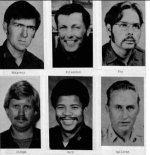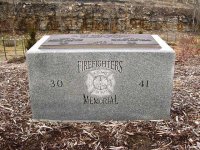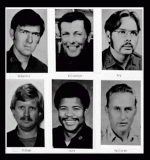
The Fires That Forged Us: Six Kansas City (MO) Firefighters Killed in Blast
11.30.2020

On November 29, 1988, six Kansas City (MO) Fire Department (KCFD) firefighters from Pumper 30 and Pumper 41 were killed in a tragic explosion.
The explosion that occurred while companies were extinguishing a fire at a construction
site and claimed the lives of six members and their vehicles—two entire pumper companies. The fire involved a trailer/magazine containing blasting mixtures of ammonium nitrate and fuel oil, most containing aluminum pellets, too. The fire also involved two other vehicles and ultimately a second trailer/magazine that also exploded.
According to a postincident report by the U.S. Fire Administration (USFA), the firefighters were not told specifically what was in the trailer/magazine, but had been cautioned by the dispatcher about explosives on the site. Exactly what they suspected was in the trailers will probably never be known.
The USFA report noted that the two captains and four firefighters involved were highly experienced. Four of the six had attended National Fire Academy (NFA) field courses on hazardous materials (Hazmat) identification. They also had Department of Transportation (DOT) Hazardous Materials Guidebooks in their vehicles.
However, the trailers/magazines containing the blasting agents probably had no markings or placards indicating their contents, and the crews may never have been sure of what was in them, especially since other, prominently marked magazines were present and may have been misconstrued to contain all the dangerous materials. The fire department was not aware of the presence of the trailers/magazines or their contents before the incident due to a lack of jurisdictional authority and because the city’s Fire Prevention and Protection Code did not require the city engineer to notify the fire department that blasting permits had been issued. (This was immediately changed after the incident.) More importantly, the KCFD had no authority or responsibility to inspect the site because it was a State enclave.
Furthermore, it is not clear that if the personnel on the scene had known of the presence of the blasting agent (ammonium nitrate mixed with fuel oil), their hazmat training, or their use of the DOT Guidebook would have necessarily led them to behave differently than they did.

Photo courtesy the Kansas City (MO) Fire Department
Those lost from Pumper 30:
Gerald C. Halloran, 57, married with three children and six grandchildren. Halloran had served more than 37 years and was considering retirement at the end of 1988.
Luther Eugene Hurd, 31, married with three children. Ordinarily he worked at Station 23 on the East Side but volunteered to fill in at Station 30 that night. He was a 10-year veteran of the department.
Thomas Fry, 41, was divorced with one child, and had been a firefighter for more than 15 years.
Those lost from Pumper 41:
James H. Kilventon Jr., 54, married with two children. He had served more than 27 years on the force.
Michael R. Oldham, 32, married with two children, an 11-year veteran of the department. His father had been a firefighter.
Robert D. McKarnin, 42, who had spent almost 20 years with the Fire Department. He served all that time at Station 41. He was married with two children.
The Incident
On November 29, 1988, an alarm was received at 0340 by the KCFD indicating there was a fire at a highway construction project. The caller, a night guard at the site, initially stated that there was a “small pickup truck” burning. In the background a woman could be
heard saying “the explosives are on fire.” The woman was later identified as another guard, according to the USFA report.
The caller went on to say “…there’s a fire on both sides of the highway.” Then, in response to the dispatcher asking “What’s burning?” the caller said: “Uh, there may be some – there’s some explosives up on a hill that I also see now is burning.”
The dispatcher then directed Pumper 41 to respond to the pickup truck fire. He added: “Pumper
41, use caution on your call. There’s information there may be explosives. It’s in a construction
area…”
Pumper Company 41 was dispatched and, upon arriving at 0346, found that there were in fact two separate fires. It radioed dispatch at 0347 to send another pumper company.
When the second company, Pumper 30, arrived, at 0352, at the second fire, which was several hundred yards away, the first company called dispatch and stated that there seemed to be two arson fires and requested that the police be sent. The first-in company also asked dispatch to warn the second company of explosives.
“If you can get 30, tell them there’s a trailer on fire up there, stay away from it … There’s supposed to be explosives involved in this.” This was at 0357, five minutes after the second company had arrived. Pumper 41 also asked that a battalion chief be sent “emergency.”
At 0359, Pumper 30 asked the dispatcher, “Can you confirm that there is explosives in this trailer or not?”
The dispatcher responded, “Pumper 41 advised that, and we have additional information on the original call that there were explosives in that area, use caution.”
To recap, at this point, both units had been advised that there were explosives on the scene, and both had acknowledged this. But they had not been told specifically that the trailer was a magazine with explosives, nor what might be on the site. They gave no indication they had seen a placard, nor that they realized the “trailer” was a magazine, nor that they knew the contents. They also did not seem alarmed, according to the USFA report.
The first company extinguished the fire in the pickup truck and proceeded to the other fire to assist the second company. A truck, a “trailer,” and a compressor – three separate vehicles – were on fire at this time (about 0402). Pumper 41 also requested that a four-wheel drive squad be sent. However, as indicated above, they appeared to have been aware that there might be explosives in the trailer.
At 0404, Pumper 41 called to Battalion Chief 107, who was en route to the scene: “Apparently this thing’s already blowed up, Chief. He’s got magnesium or something burning up here.”
At 0408, approximately 22 minutes after the first pumper company arrived on the scene and approximately 16 minutes after the second company arrived on the scene a catastrophic explosion occurred.
All six firefighters assigned to both companies were killed. The battalion chief and his driver who had just arrived and stopped about a quarter mile away received minor injuries. Their windshield was blown in.
After the first explosion, the battalion chief immediately pulled back and prevented other firefighters from entering the area. A command post was set up at a safe distance.
Approximately 40 minutes later, a second explosion occurred, followed by several minor explosions.
The explosions broke windows far from the site and were heard through a wide area. There were two large craters found where the two trailers had been. The first trailer explosion created a swimming pool-like crater, with a “deep part” 80 feet in diameter and eight feet deep connected to a smaller crater 20 feet in diameter and six feet deep. The second trailer explosion created a crater approximately 100 feet in diameter and eight feet deep.
According to the
Kansas City Star, in July 1996, police charged five in the arson that ultimately led to these firefighters’ deaths. In July 1997 a jury convicted the five: Frank Sheppard; his brother Earl “Skip” Sheppard; Bryan Sheppard, a nephew of Frank and Earl; Darlene Edwards, Frank Sheppard’s girlfriend; and Richard Brown.
A look back at a deadly 1988 explosion that claimed the lives of six Kansas City (MO) firefighters and destroyed two vehicles.

www.fireengineering.com






